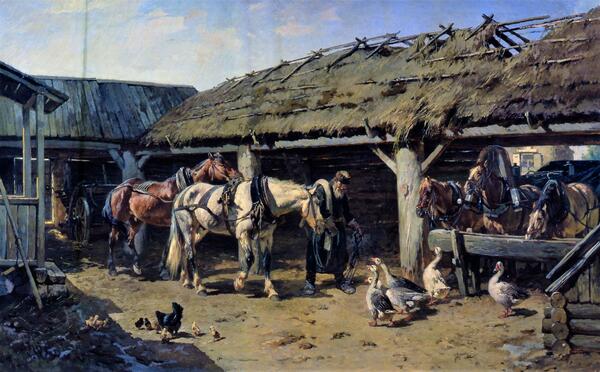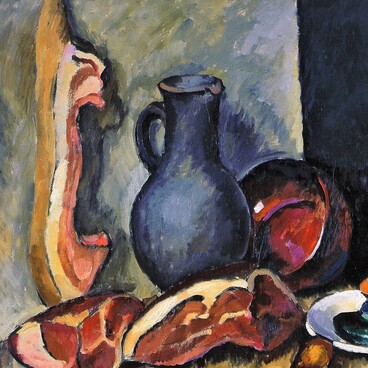Artist Rudolf Frentz was born in Berlin in 1831. He graduated from the Berlin Academy of Arts in 1854. Several years later, he moved to Saint Petersburg, where he painted portraits on commission.
He became famous in artistic circles, as he received imperial commissions to produce portraits from members of the Russian Royal Family. He created portraits for the Grand Duke Nicholas Nikolaevich the Elder, and accompanied him in his trip across Russia. He was commissioned for several paintings by the Grand Duke Vladimir Romanov, the third son of Emperor Alexander II. Over a period of several years, Frentz belonged to the retinue of the future emperor Alexander III and took part in many military operations.
In 1884, Frentz became a Russian citizen and an honorary free member of the Imperial Academy of Arts in 1885. He was granted Honorary Citizenship in 1904. He received the title of academician in 1912. Frentz was a prominent animal painter and excelled in battle and genre painting, as well. Horses depicted in rapid motion were one of his favorite images. As a court painter, he created portraits of members of the Russian Imperial House during their trips and horse-riding strolls, as well as panoramic paintings dedicated to military actions and imperial hunting expeditions, a favorite court entertainment in summer and winter.
During the reign of Emperors Nicholas I, Alexander II and Alexander III, Gatchina was the prime destination for hunting parties, which was visited by members of European Royal families and foreign ambassadors. Gatchina also became the place of residence for Frentz: he was granted land for his estate.
In the painting ‘At the Inn’, displayed in the museum, one can notice all characteristic features of the 19th century art: the utmost realism, depiction of people of different social classes and naturalism. The painting is extremely detailed: he depicted the old thatched roof, three harnessed horses at the drinking-trough, the cabby with a harness in his hands. Frentz meticulously painted the images of animals: angry geese pull their necks towards the cabby; a chicken and chickens move around the yard next to them. Therefore, art specialists attribute this work to the animalist genre.
In addition to battle scenes and animalier art, Frentz created urban and rural landscapes, watercolors and graphic sketches. His artworks are housed in major museums, including the State Tretyakov Gallery, the Scientific-research Museum of the Russian Academy of Arts, and others.
He became famous in artistic circles, as he received imperial commissions to produce portraits from members of the Russian Royal Family. He created portraits for the Grand Duke Nicholas Nikolaevich the Elder, and accompanied him in his trip across Russia. He was commissioned for several paintings by the Grand Duke Vladimir Romanov, the third son of Emperor Alexander II. Over a period of several years, Frentz belonged to the retinue of the future emperor Alexander III and took part in many military operations.
In 1884, Frentz became a Russian citizen and an honorary free member of the Imperial Academy of Arts in 1885. He was granted Honorary Citizenship in 1904. He received the title of academician in 1912. Frentz was a prominent animal painter and excelled in battle and genre painting, as well. Horses depicted in rapid motion were one of his favorite images. As a court painter, he created portraits of members of the Russian Imperial House during their trips and horse-riding strolls, as well as panoramic paintings dedicated to military actions and imperial hunting expeditions, a favorite court entertainment in summer and winter.
During the reign of Emperors Nicholas I, Alexander II and Alexander III, Gatchina was the prime destination for hunting parties, which was visited by members of European Royal families and foreign ambassadors. Gatchina also became the place of residence for Frentz: he was granted land for his estate.
In the painting ‘At the Inn’, displayed in the museum, one can notice all characteristic features of the 19th century art: the utmost realism, depiction of people of different social classes and naturalism. The painting is extremely detailed: he depicted the old thatched roof, three harnessed horses at the drinking-trough, the cabby with a harness in his hands. Frentz meticulously painted the images of animals: angry geese pull their necks towards the cabby; a chicken and chickens move around the yard next to them. Therefore, art specialists attribute this work to the animalist genre.
In addition to battle scenes and animalier art, Frentz created urban and rural landscapes, watercolors and graphic sketches. His artworks are housed in major museums, including the State Tretyakov Gallery, the Scientific-research Museum of the Russian Academy of Arts, and others.



